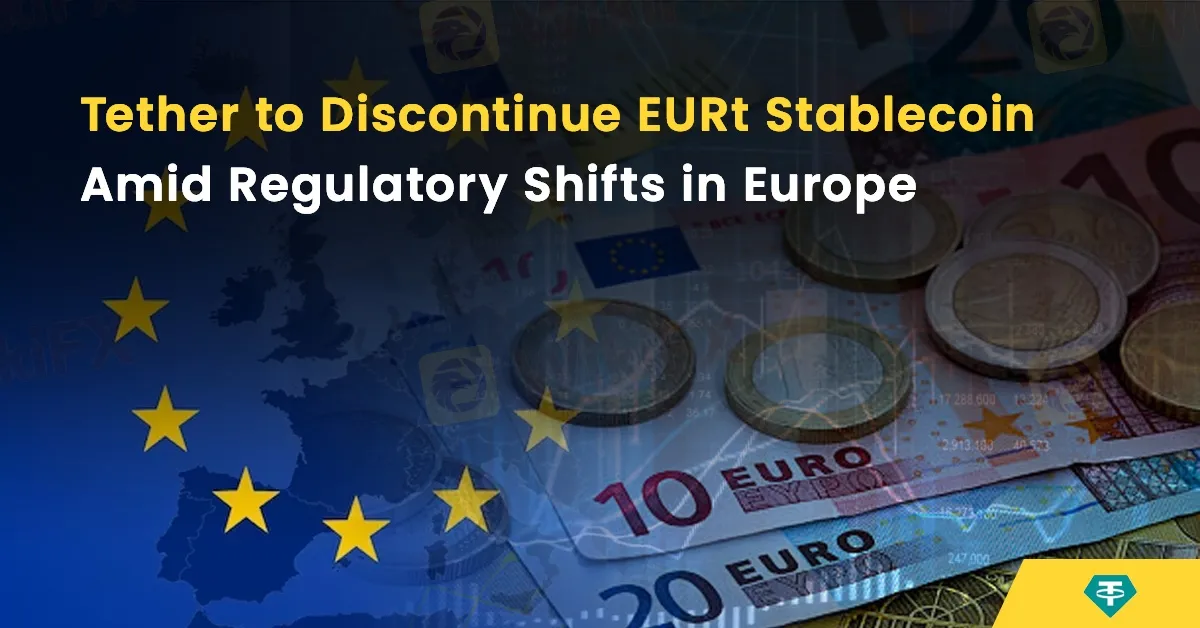简体中文
繁體中文
English
Pусский
日本語
ภาษาไทย
Tiếng Việt
Bahasa Indonesia
Español
हिन्दी
Filippiiniläinen
Français
Deutsch
Português
Türkçe
한국어
العربية
Tether to Discontinue EURt Stablecoin Amid Regulatory Shifts in Europe
Abstract:Tether, the issuer of the world’s largest stablecoin, USDt, has announced that it will cease support for its euro-pegged stablecoin, EURt (EURT), across all blockchains. Users are required to redeem their EURt holdings by 25 November 2025, following the company’s decision to phase out the token.

Tether, the issuer of the world‘s largest stablecoin, USDt, has announced that it will cease support for its euro-pegged stablecoin, EURt (EURT), across all blockchains. Users are required to redeem their EURt holdings by 25 November 2025, following the company’s decision to phase out the token.
The move comes in response to evolving regulatory landscapes in Europe, particularly the forthcoming Markets in Crypto-Assets (MiCA) regulation, which is set to take full effect by the end of 2024. In a statement released on 27 November, Tether highlighted that its decision aligns with a strategic evaluation of the regulatory frameworks affecting stablecoins in the European market. The company underscored its commitment to prioritising community interest when deciding which tokens to support.

Introduced in 2016, EURt was designed to provide a stable euro-backed asset for the cryptocurrency market, maintaining a 1:1 peg with the euro. However, despite its longevity, EURt has struggled to gain significant traction. With a market capitalisation of just $27 million, it accounts for a mere 0.02% of the market cap of its USD-backed counterpart, USDt. Tether revealed that the last request to mint new EURt tokens was processed in 2022, signalling a decline in demand well before the current decision to retire the stablecoin.
Tether‘s exit from the euro stablecoin market reflects growing regulatory scrutiny under MiCA, which introduces stringent requirements for stablecoin issuers, including reserve management and transparency. Tether’s CEO, Paolo Ardoino, has previously criticised the MiCA framework, arguing that it could introduce systemic risks to the banking sector by imposing overly rigid controls on stablecoin operations.
Despite retiring EURt, Tether remains committed to supporting regulatory-compliant innovations. The company has backed several MiCA-compliant projects, including EURq and USDq stablecoins developed by the Dutch fintech firm Quantoz Payments. These stablecoins, created in partnership with Kraken exchange and Fabric Ventures, will use Tethers proprietary Hadron technology to streamline compliance, anti-money laundering processes, and blockchain integration for issuers.
Currently, Circle‘s EURC and Société Générale’s EURCV dominate the euro stablecoin market, holding a combined market share of 67%. Quantozs EURq aims to carve out a niche in this competitive space. As part of its compliance with MiCA regulations, Quantoz will maintain 2% of the EURq token supply on its balance sheet, ensuring transparency and accountability.
Tether‘s strategic pivot extends beyond the euro market. The company recently announced partnerships with UAE-based firms Phoenix Group and Green Acorn Investments to develop a dirham-pegged stablecoin. This initiative highlights Tether’s ongoing efforts to expand its portfolio while navigating complex regulatory environments.

Disclaimer:
The views in this article only represent the author's personal views, and do not constitute investment advice on this platform. This platform does not guarantee the accuracy, completeness and timeliness of the information in the article, and will not be liable for any loss caused by the use of or reliance on the information in the article.
Read more

What Are The Top 5 Cryptocurrency Predictions For 2025?
Discover the top 5 cryptocurrency predictions for 2025, including Ethereum's rise, a potential bear market, meme coin struggles, and regulatory shifts.

Stablecoins: The New Frontier in Digital Finance?
In 2024, while Bitcoin’s surge past US$100,000 captured global attention, financial institutions turned their focus to stablecoins. Will stablecoins be the new frontier in digital finance for the year of 2025?

Top 9 Financial Fraud Cases in Recent History
Know the top 9 financial fraud cases in history, from Enron to FTX, uncovering deception and greed. Learn how WikiFX protects investors from scams and fraud.

KuCoin Pay Introduces Easy Crypto Payments for Merchants
How KuCoin Pay, an innovative PoS system enabling merchants to accept 54 cryptocurrencies, including Bitcoin, Ethereum, and USDT, for seamless transactions.
WikiFX Broker
Latest News
Will Gold Break $2,625 Amid Fed Caution and Geopolitical Risks?
ECB Targets 2% Inflation as Medium-Term Goal
New Year, New Surge: Will Oil Prices Keep Rising?
PH SEC Issues Crypto Guidelines for Crypto-Asset Service Providers
FTX Chapter 11 Restructuring Plan Activated: $16 Billion to Be Distributed
Think Before You Click: Malaysian Loses RM240,000 to Investment Scam
Bithumb CEO Jailed and Fined Over Bribery Scheme in Token Listing Process
WikiFX Review: Something You Need to Know About Saxo
Is PGM Broker Reliable? Full Review
Terraform Labs Co-founder Do Kwon Extradited to the U.S. to Face Fraud Charges
Currency Calculator






